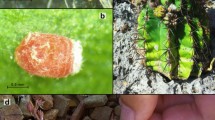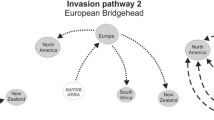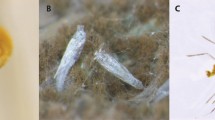Abstract
Novel host plant–insect interactions often arise from human-mediated introductions of potential hosts to areas inhabited by native insects, or invasive insects to regions with suitable hosts. These novel interactions may drive ecological and evolutionary change in native species. Here we investigate the role of the introduction of the prickly pear Opuntia ficus-indica on the demographic history of the native moth Cactoblastis cactorum. The latter became a pest in its native range after the introduction of the economically cultivated prickly pear. We evaluated potential scenarios of long-term population size changes by applying a demographic simulation framework to a large set of high-throughput sequence data. We sampled populations of the cactus moth from regions of historical incidence of prickly pear crop, in central and northwestern Argentina. To shed insight into the shared history of the exotic cactus/native moth system we integrated the historical records of the introduction of O. ficus-indica in South America into the demographic simulation. We also included a null hypothesis of stable population and/or ancient population changes. Our results reveal population size changes in both Quaternary and contemporary C. cactorum populations. Simulations pointed to a recent population expansion that coincided with the hypothesis of the introduction of the prickly pear after the arrival of Europeans in South America. The presence of the new host during the last centuries apparently prompted the expansion of C. cactorum. Overall, our results are of interest to understand the ongoing impact of introduced species and the complex ecological adjustments of native insects that occur with the introduction of new hosts.
Graphical Abstract




Similar content being viewed by others
Data availability
Following open research and reproducibility principles, our study's datasets can be accessed on Figshare (https://doi.org/https://doi.org/10.6084/m9.figshare.23938227), and the automation of demographic simulation framework is available on GitHub (https://github.com/niconm89/pipeFSC). The raw reads are accessible through NCBI under BioProject PRJNA666743.
References
Aponte-Díaz LA, Ruiz-Arocho J, Carrera-Martínez R, van Ee BW (2020) Contrasting effects of the invasive Hypogeococcus sp. (Hemiptera: Pseudococcidae) infestation on seed germination of Pilosocereus royenii (Cactaceae), a Puerto Rican native cactus. Caribb J Sci 50:212–218. https://doi.org/10.18475/cjos.v50i2.a2
Bartoleti LF, Peres EA, Sobral-Souza T et al (2017) Phylogeography of the dry vegetation endemic species Nephila sexpunctata (Araneae: Araneidae) suggests recent expansion of the neotropical dry diagonal. J Biogeogr 44:2007–2020. https://doi.org/10.1111/jbi.12998
Bennett GM, O’Grady PM (2012) Host-plants shape insect diversity: phylogeny, origin, and species diversity of native Hawaiian leafhoppers (Cicadellidae: Nesophrosyne). Mol Phylogenet Evol 65:705–717. https://doi.org/10.1016/j.ympev.2012.07.024
Bezemer TM, Harvey JA, Cronin JT (2014) Response of native insect communities to invasive plants. Annu Rev Entomol 59:119–141. https://doi.org/10.1146/annurev-ento-011613-162104
Borer M, Arrigo N, Buerki S, Naisbit RE, Alvarez N (2012) Climate oscillations and species interactions: large-scale congruence but regional differences in the phylogeographic structures of an alpine plant and its monophagous insect. J Biogeogr 39:1487–1498. https://doi.org/10.1111/j.1365-2699.2012.02703.x
Brändle M, Kühn I, Klotz S, Belle C, Brandl R (2008) Species richness of herbivores on exotic host plants increases with time since introduction of the host. Divers Distrib 14:905–912. https://doi.org/10.1111/j.1472-4642.2008.00511.x
Carroll SP (2007) Natives adapting to invasive species: ecology, genes, and the sustainability of conservation. Ecol Res 22:892–901. https://doi.org/10.1007/s11284-007-0352-5
Cogni R (2010) Resistance to plant invasion? a native specialist herbivore shows preference for and higher fitness on an introduced host. Biotropica 42:188–193. https://doi.org/10.1111/j.1744-7429.2009.00570.x
Danecek P et al (2011) The variant call format and VCFtools. Bioinform 27:2156–2158. https://doi.org/10.1093/bioinformatics/btr330
de Pedro M, Riba M, González-Martínez SC, Seoane P, Bautista R, Claros MG, Mayol M (2021) Demography, genetic diversity and expansion load in the colonizing species Leontodon longirostris (Asteraceae) throughout its native range. Mol Ecol 30(5):1190–1205. https://doi.org/10.1111/mec.15802
DeChaine EG, Martin AP (2006) Using coalescent simulations to test the impact of quaternary climate cycles on divergence in an alpine plant-insect association. Evol 60:1004–1013. https://doi.org/10.1111/j.0014-3820.2006.tb01178.x
Donkin R, Red S (1977) An ethnographical study of Cochineal and the Opuntia Cactus. Am Philos Soc 67:1–84
Eaton DA, Overcast I (2020) ipyrad: interactive assembly and analysis of RADseq datasets. Bioinform 36:2592–2594. https://doi.org/10.1093/bioinformatics/btz966
Ervin GN (2012) Indian fig cactus (Opuntia Ficus-Indica (L.) Miller) in the Americas: an uncertain history. Haseltonia 2012:70–81. https://doi.org/10.2985/1070-0048-17.1.9
Excoffier L, Dupanloup I, Huerta-Sánchez E, Sousa VC, Foll M (2013) Robust demographic inference from genomic and SNP data. PLoS Genet 9:1003905. https://doi.org/10.1371/journal.pgen.1003905
Facon B, Hafsi A, Charlery De La Masseliere M et al (2021) Joint species distributions reveal the combined effects of host plants, abiotic factors and species competition as drivers of species abundances in fruit flies. Ecol Lett 24:1905–1916. https://doi.org/10.1111/ele.13825
Felker P, Soulier C, Leguizamon G, Ochoa J (2002) A comparison of the fruit parameters of 12 Opuntia clones grown in Argentina and the United States. J Arid Environ 52:361–370. https://doi.org/10.1006/jare.2002.1001
Foll M (2012) BayeScan v2. 1 user manual. Ecol 20:1450–1462
Forister ML, Wilson JS (2013) The population ecology of novel plant–herbivore interactions. Oikos 122:657–666. https://doi.org/10.1111/j.1600-0706.2013.00251.x
Frichot E, François O (2015) LEA: an R package for landscape and ecological association studies. Meth Ecol Evol 8:925–929. https://doi.org/10.1111/2041-210X.12382
Frichot E, Mathieu F, Trouillon T, Bouchard G, François O (2014) Fast and efficient estimation of individual ancestry coefficients. Genet 4:973–983. https://doi.org/10.1534/genetics.113.160572
Gassmann AJ, Onstad DW, Pittendrigh BR (2009) Evolutionary analysis of herbivorous insects in natural and agricultural environments. Pest Manag Sci 65:1174–1181. https://doi.org/10.1002/ps.1844
Gonzalez JC, Medina RG, Nieto C (2023) Genetic diversity and climatic suitability over time of Baetodes huaico (Ephemeroptera: Baetidae). Zool Anz 306:108–118. https://doi.org/10.1016/j.jcz.2023.07.006
Goudet J (2005) Hierfstat, a package for R to compute and test hierarchical F-statistics. Mol Ecol Notes 5:184–186. https://doi.org/10.1111/j.1471-8286.2004.00828.x
Griffith MP (2004) The origins of an important cactus crop, Opuntia ficus-indica (Cactaceae): new molecular evidence. Am J Bot 91:1915–1921. https://doi.org/10.3732/ajb.91.11.1915
Hernández-Hernández T, Wiens JJ (2020) Why are there so many flowering plants? a multiscale analysis of plant diversification. Am Nat 195:948–963. https://doi.org/10.1086/708273
Hight SD, Carpenter JE (2009) Flight phenology of male Cactoblastis cactorum (Lepidoptera: Pyralidae) at different latitudes in the southeastern United States. Fla Entomol 92:208–216. https://doi.org/10.1653/024.092.0203
Hofmeister NR, Werner SJ, Lovette IJ (2021) Environmental correlates of genetic variation in the invasive European starling in North America. Mol Ecol 30(5):1251–1263
Inglese P, Basile F, Schirra M (2002) Cactus pear fruit production. In: Nobel PS (ed) Cacti: Biology and uses. University of California Press, Berkeley, pp 163–183
Inglese P, Mondragon C, Nefzaoui A, Saenz C (2017) Crop ecology, cultivation and uses of cactus pear. Food and Agriculture Organization of the United Nations (FAO)
Jahner JP, Bonilla MM, Badik KJ, Shapiro AM, Forister ML (2011) Use of exotic hosts by Lepidoptera: widespread species colonize more novel hosts. Evol 65:2719–2724. https://doi.org/10.1111/j.1558-5646.2011.01310.x
Jermy T (1984) Evolution of insect/host plant relationships. Am Nat 124:609–630. https://doi.org/10.1086/284302
Keightley PD, Pinharanda A, Ness RW et al (2015) Estimation of the spontaneous mutation rate in Heliconius melpomene. Mol Biol Evol 1:239–243. https://doi.org/10.1093/molbev/msu302
Kenis M, Auger-Rozenberg MA, Roques A et al (2008) Ecological effects of invasive alien insects. Biol Invasions 11:21–45. https://doi.org/10.1007/s10530-008-9318-y
Kiesling R (1988) Origen, domesticación y distribución de Opuntia ficus-indica. J Prof Assoc Cactus Dev 3:50–59
Kistler L, Maezumi SY, Gregorio de Souza J et al (2018) Multiproxy evidence highlights a complex evolutionary legacy of maize in South America. Science 362:1309–1313
Köhler M, Esser LF, Font F, Souza-Chies TT, Majure LC (2020) Beyond endemism, expanding conservation efforts: what can new distribution records reveal? Perspect Plant Ecol Evol Syst 45:125543. https://doi.org/10.1016/j.ppees.2020.125543
Köhler M, Oakley L, Font F, Las Peñas ML, Majure LC (2021) On the continuum of evolution: a putative new hybrid speciation event in Opuntia (Cactaceae) between a native and an introduced species in southern South America. Syst Biodivers 19:1026–1039. https://doi.org/10.1080/14772000.2021.1967510
Liu X, Fu YX (2020) Stairway Plot 2: demographic history inference with folded SNP frequency spectra. Genome Biol 21:280. https://doi.org/10.1186/s13059-020-02196-9
Lynch M, Conery JS (2003) The origins of genome complexity. Science 302:1401–1404. https://doi.org/10.1126/science.1089370
Majure LC, Köhler M, Font F (2020) North American Opuntias (Cactaceae) in Argentina? remarks on the phylogenetic position of Opuntia penicilligera and a closer look at O. ventanensis. Phytotaxa 14(428):279–289. https://doi.org/10.11646/phytotaxa.428.3.9
McFadyen RE (1985) Larval characteristics of Cactoblastis spp. (Lepidoptera: Pyralidae) and the selection of species for biological control of prickly pears (Opuntia spp.). B Entomol Res 75:159–168. https://doi.org/10.1017/S0007485300014231
McGruddy RA, Howse MW, Haywood J et al (2021) Invasive paper wasps have strong cascading effects on the host plant of monarch butterflies. Ecol Entomol 46:459–469. https://doi.org/10.1111/een.12992
Mooney HA, Cleland EE (2001) The evolutionary impact of invasive species. PNAS 98:5446–5451. https://doi.org/10.1073/pnas.091093398
Montenegro G, Acosta MC, Caeiro L, Varone L, Las Peñas ML (2024) Tracing the geographic origins of two forms of Opuntia ficus-indica cultivated in Argentina using haplotype diversity patterns, and cytogenetic and morphological analyses. Genet Resour Crop Evol. https://doi.org/10.1007/s10722-024-01876-w
Moreno ES, de Freitas LB, Speranza PR, Solís VG (2018) Impact of Pleistocene geoclimatic events on the genetic structure in mid-latitude South American plants: insights from the phylogeography of Turnera sidoides complex (Passifloraceae, Turneroideae). Bot J Linn Soc 188:377–390. https://doi.org/10.1093/botlinnean/boy062
Morrone JJ (2014) Biogeographical regionalisation of the Neotropical region. Zootaxa 3782:1–110. https://doi.org/10.11646/zootaxa.3782.1.1
Muchoney ND, Deane Bowers M, Carper AL, Teglas MB, Smilanich AM (2023) Use of an exotic host plant reduces viral burden in a native insect herbivore. Ecol Lett 26:425–436. https://doi.org/10.1111/ele.14162
Novoa S (2006) Sobre el Origen de la Tuna en el Perú Algunos alcances. Zonas Áridas 10:174–181
Ochoa MJ, Targa MG, Abdala G, Leguizamón G (2007) Extending fruiting season of cactus pear (Opuntia ficus-índica (l.) miller) in Santiago del Estero, Argentina. In VI Int Congr Cactus Pear Cochineal 811:87–90. https://doi.org/10.17660/actahortic.2009.811.7
Orsucci M, Audiot P, Dorkeld F et al (2018) Larval transcriptomic response to host plants in two related phytophagous lepidopteran species: implications for host specialization and species divergence. BMC Genom 19:265. https://doi.org/10.1186/s12864-018-4589-x
Ortego J, Noguerales V, Tonzo V, González-Serna MJ, Cordero PJ (2021) Broadly distributed but genetically fragmented: demographic consequences of pleistocene climatic oscillations in a common iberian grasshopper. Insect Syst 5:2. https://doi.org/10.1093/isd/ixab009
Peterson BK, Weber JN, Kay EH, Fisher HS, Hoekstra HE (2012) Double Digest RADseq: an inexpensive method for De Novo SNP discovery and genotyping in model and non-model species. PLoS ONE 7:37135. https://doi.org/10.1371/journal.pone.0037135
Poveda-Martínez D, Noguerales V, Hight S, Logarzo G, Emerson BC, Varone L, Hasson E (2023) Geography, climate and shifts in host plants distribution explain the genomic variation in the cactus moth. Front Ecol Evol 11:1260857. https://doi.org/10.3389/fevo.2023.1260857
Poveda-Martínez D, Varone L, Fuentes Corona M, Hight S, Logarzo G, Hasson E (2022) Spatial and host related genomic variation in partially sympatric cactophagous moth species. Mol Ecol 31:356–371. https://doi.org/10.1111/mec.16232
Purcell S, Neale B, Todd-Brown K et al (2007) PLINK: a tool set for whole-genome association and population-based linkage analyses. Am J Hum Genet 3:559–575. https://doi.org/10.1086/519795
Reddy GVP, Guerrero A (2004) Interactions of insect pheromones and plant semiochemicals. Trends Plant Sci 9:253–261. https://doi.org/10.1016/j.tplants.2004.03.009
Richard M, Tallamy DW, Mitchell AB (2019) Introduced plants reduce species interactions. Biol Invasions 21:983–992. https://doi.org/10.1007/s10530-018-1876-z
Rodriguero MS, Lanteri AA, Guzmán NV, Carús Guedes JV, Confalonieri VA (2016) Out of the forest: past and present range expansion of a parthenogenetic weevil pest, or how to colonize the world successfully. Ecol Evol 6:5431–5445. https://doi.org/10.1002/ece3.2180
Rosetti N, Krohling D, Remis MI (2022) Evolutionary history and colonization patterns of the wing dimorphic grasshopper Dichroplus vittatus in two Argentinean biomes. Sci Rep 12:2920. https://doi.org/10.1038/s41598-022-05162-6
Rozas J, Ferrer-Mata A, Sánchez-DelBarrio JC et al (2017) DnaSP 6: DNA sequence polymorphism analysis of large data sets. Mol Biol Evol 34:3299–3302. https://doi.org/10.1093/molbev/msx248
Schoonhoven LM, Van Loon JJ, Dicke M (2005) Insect-plant biology. Oxford University Press
Schwarz G (1978) Estimating the dimension of a model. Ann Stat 6:461–464
Strauss SY, Lau JA, Carroll SP (2006) Evolutionary responses of natives to introduced species: what do introductions tell us about natural communities? Ecol Lett 9:357–374. https://doi.org/10.1111/j.1461-0248.2005.00874.x
Shiojiri K, Takabayashi J, Yano S, Takafuji A (2002) Oviposition preferences of herbivores are affected by tritrophic interaction webs. Ecol Lett 5:186–192. https://doi.org/10.1046/j.1461-0248.2002.00292.x
Stoneking M, Arias L, Liu D, Oliveira S, Pugach I, Rodriguez JJ (2023) Genomic perspectives on human dispersals during the Holocene. PNAS 120:2209475119. https://doi.org/10.1073/pnas.2209475119
Tajima F (1989) The effect of change in population size on DNA polymorphism. Genet 123:597–601. https://doi.org/10.1093/genetics/123.3.597
Varone L, Acosta MM, Logarzo GA, Briano JA, Hight SD, Carpenter JE (2012) Laboratory performance of Cactoblastis Cactorum (Lepidoptera: Pyralidae) on south and north American Opuntia species occurring in Argentina. Fla Entomol 95:1163–1173. https://doi.org/10.1653/024.095.0447
Varone L, Aguirre MB, Lobos E, Pérez DR, Hight SD, Palottini F, Guala M, Logarzo GA (2019) Causes of mortality at different stages of Cactoblastis cactorum in the native range. Biocontrol 64:249–261. https://doi.org/10.1007/s10526-019-09938-0
Varone L, Logarzo GA, Briano JA, Hight SD, Carpenter JE (2014) Cactoblastis cactorum (Berg) (Lepidoptera: Pyralidae) use of Opuntia host species in Argentina. Biol Invasions 16:2367–2380. https://doi.org/10.1007/s10530-014-0670-9
Weir GH, Bonavia D (1985) Coprolitos y dieta del Precerámico Tardío de la costa peruana. Bull Inst Fr Études Andines 14:85–140. https://doi.org/10.3406/bifea.1985.1596
Wiens JJ, Lapoint RT, Whiteman NK (2015) Herbivory increases diversification across insect clades. Nat Commun 6:8370. https://doi.org/10.1038/ncomms9370
Wright A (2021) Agriculture and biodiversity in Latin America in historical perspective. Oxford Research Encyclopedia of Latin American History Oxford University Press https://doi.org/10.1093/acrefore/9780199366439.013.991
Acknowledgements
We are grateful to the Associate Editor and two anonymous reviewers for suggestions that helped to improve previous versions of this paper. We express our gratitude to Guillermo Logarzo (FuEDEI) and Stephen Hight (USDA) for their fieldwork support and valuable insights during the conception of this study, and Arabella Peard Bugliani (FuEDEI) for her revision and comments on English use and grammar. We would like to thank Biocódices S.A. for granting the use of computational resources. Funding was obtained from USDA APHIS-PPQ, Farm Bill 10201 and through PICT 1447/2016 awarded by FONCyT Argentina. D.P.M. and N.N.M are recipients of a postdoctoral scholarship awarded by CONICET. E.H. and L.V. are members of Carrera del Investigador CONICET.
Funding
This work was supported by the United States Department of Agriculture, Animal and Plant Health Inspection Service—Plant Protection and Quarantine (USDA APHIS-PPQ), Farm Bill 10201; and by the Fondo para la Investigación Científica y Tecnológica (FONCYT) of Argentina PICT 1447/2016.
Author information
Authors and Affiliations
Contributions
D.P.M., E.H., and L.V., designed the project. D.P.M., E.H., and L.V., performed field collections. D.P.M., conducted molecular work and data analyses. N.N.M., Implemented the automation of demographic simulations. D.P.M drafted the manuscript, E.H and L.V., reviewed and edited the manuscript. All coauthors made contributions to the final version of the manuscript and approved the manuscript submission.
Corresponding author
Ethics declarations
Conflict of interest
The authors have no relevant financial or non-financial interests to disclose.
Additional information
Publisher's Note
Springer Nature remains neutral with regard to jurisdictional claims in published maps and institutional affiliations.
Rights and permissions
Springer Nature or its licensor (e.g. a society or other partner) holds exclusive rights to this article under a publishing agreement with the author(s) or other rightsholder(s); author self-archiving of the accepted manuscript version of this article is solely governed by the terms of such publishing agreement and applicable law.
About this article
Cite this article
Poveda-Martínez, D., Moreyra, N.N., Hasson, E. et al. Demographic inference provides evidence of a quaternary-driven impact on the cactus moth and sheds light on the putative role of an exotic host. Biol Invasions (2024). https://doi.org/10.1007/s10530-024-03317-2
Received:
Accepted:
Published:
DOI: https://doi.org/10.1007/s10530-024-03317-2




